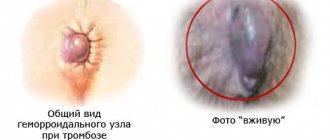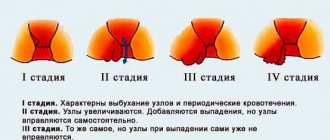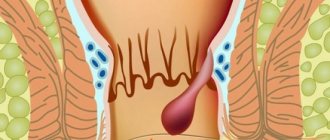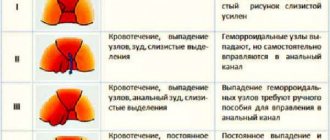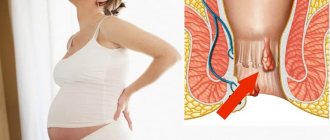Chronic hemorrhoids 3 degrees
If a person suffering from hemorrhoidal disease does not consult a doctor or does not follow the recommendations given to him, the chronic course of hemorrhoids steadily leads him to the third stage of the disease. Signs of pathology periodically worsen, cause discomfort, reduce quality of life, and require surgical intervention.
Chronic internal hemorrhoids stage 3 with transition to the fourth are the result of a neglectful attitude towards one’s health in the initial stages of the disease.
Hemorrhoids never appear out of nowhere, therefore the location of inflamed hemorrhoids is similar to stages 1 and 2 of the disease:
- rectum, rectum inside;
- external or external - around the anus;
- combined.
The third stage of hemorrhoidal disease is a period of complications that poses a danger to human health and life. Patients require urgent consultation with a proctologist, otherwise there is a risk of transition to critical stage 4 of the disease, when surgical intervention may not be enough to correct the dangerous condition.
Prevention
Lifestyle correction will help prevent the further development of hemorrhoids.
It is necessary to exclude all provoking factors:
- Smoking and alcohol
- Strength sports, weight lifting,
- Passive lifestyle,
- Frequent stress
- Harmful products.
The patient should walk more in the fresh air, do therapeutic exercises and strengthening Kegel exercises daily, give up alcohol and follow a gentle diet.
Removal of stage 3 hemorrhoids is not a guarantee of complete recovery; if the regime is violated, new lumps may form and the disease may recur.
Treatment at home should continue after surgery.
General restorative teas with crushed leaves, lemon balm and rose hips, and herbal decoctions are useful:
- Horse chestnut seeds,
- Sage, yarrow,
- Birch buds.
It is important to strictly observe the rules of hygiene; once a season you need to take dietary supplements containing vitamins C, A, E, zinc, magnesium and iodine.
Main symptoms
The clinical symptoms of the third stage are characterized by the same signs as hemorrhoids in the initial stages of their development, only the symptoms are pronounced due to the size of the nodes, their number and the degree of inflammation.
Internal hemorrhoids stage 3
The main difference between rectal pathology of this period is the prolapse of hemorrhoids with any effort without self-reduction into place. The reason is dystrophic changes in the venous blood flow system of the anorectal region, combined with weakness of the muscles and ligaments of the anus. Due to the large size of hemorrhoidal formations, the deformed muscles of the rectum become unable to support varicose veins, so they can only be reduced with the help of hands. Reduction is necessary, since in the rectum cavity they are more reliably protected from injury and strangulation.
In addition, many people notice:
- severe itching and burning in the perianal area before and after defecation, as well as during prolonged sitting;
- inflammatory exudate from the rectum irritates nearby tissues with symptoms of dermatitis or eczema, cracks form, proctitis and paraproctitis occur;
- pain during bowel movements becomes too strong and requires the use of medications;
- hemorrhoids are constantly touched up .
The symptoms are so pronounced that the person’s ability to work is impaired, and he is forced to seek help from a proctologist.
External hemorrhoids 3rd degree
It is characterized by all the symptoms of internal hemorrhoids, with the exception of prolapse of nodes. But there are also some peculiarities:
- cavernous formations grow in volume, their skin becomes thin, so with any careless movement or straining during defecation, local bleeding opens, which is noticeable by marks on toilet paper;
- bleeding is accompanied by pain, which increases with coughing and sneezing;
- the nodes thrombose , the pain can be unbearable;
- a feeling of a foreign body in the anus ;
- irritation of the perianal area causes the appearance of anal fissures, and there is a risk of secondary infection, suppuration, and ascending infection in the pelvic organs.
Hemorrhoids can be felt independently in the form of lumps surrounding the anus.
What happens if you don’t see a doctor in time?
The third stage of hemorrhoids is a serious disease that requires immediate assistance from specialists. The lack of qualified treatment leads to complications, transition to the most complex, life-threatening form - the fourth. The last stage of hemorrhoids is treated exclusively by surgery.
- The presence of cracks in the anus opens the door for pathogens to enter the intestines. Inflammation progresses, mucus and pus begin to be released, accompanied by an unpleasant odor.
- Loss of sphincter elasticity leads to uncontrolled release of feces. Irritation of the rectal mucosa occurs, ulcers, erosions, and wounds appear. The passage of feces during defecation provokes bleeding of varying intensity.
- Loss of nodes is dangerous due to strangulation, thrombosis, and tissue necrosis. This situation requires emergency surgical intervention.
The danger of stage 3 hemorrhoidal disease
Ignoring the symptoms of hemorrhoids leads to the development of serious complications that threaten a person’s life:
- secondary infection with the development of erosions, ulcers, fistulas, abscess formation of anorectal tissue, the risk of developing sepsis;
- bleeding causing anemia;
- thrombosis of nodes with severe pain, microinfarctions of the pelvic organs due to impaired microcirculation;
- strangulation - involuntary confluence of cavities can provoke a sensitive anal valve to contract, which will cause spasm of the anus and strangulation of the hemorrhoid with pain syndrome up to fainting;
- necrosis is a consequence of thrombosis or strangulation with the development of blood stasis in the venous plexuses, the occurrence of inflammation, secondary infection, death of the mucous membrane, suppuration, and sepsis.
Chronic and severe combined hemorrhoids of stage 3 are an extremely dangerous condition, precisely because of the risk of lethal complications, contacting a proctologist is vital.
Causes
Certain factors can cause the combined type of hemorrhoids:
- Frequent constipation and intestinal motility disorders. Such conditions can provoke an inflammatory process in hemorrhoids.
- Pregnancy and childbirth. Changes in the size of the uterus during pregnancy and childbirth place high pressure on the veins of the hemorrhoids.
- Proctological diseases. Sphincteritis, anal fissures, irritable bowel syndrome and other diseases can cause combined hemorrhoids. Increases the likelihood of developing hemorrhoids of this type and the inflammatory process in hemorrhoidal veins with varicose veins.
- Excess weight and passive lifestyle. These factors are quite common. High pressure on the anus due to obesity and prolonged sitting are statistical stresses and provoke inflammation in the hemorrhoidal veins.
- Excessive physical activity.
- Poor nutrition, resulting in periodic constipation;
- Previous hepatitis C;
- Alcohol abuse;
- Having anal sex;
- Diseases accompanied by circulatory problems in the pelvis;
- Age-related changes. Hemorrhoids develop as a result of poor circulation in the pelvis, which is associated with loss of vascular elasticity.
Heredity is also an important factor.
Diagnostics
The algorithm for examining a patient with hemorrhoids is standard:
- history taking, visual examination, digital examination of the rectum (sometimes the patient may be asked to cough to assess the condition of the nodes, the degree of bleeding, the possibility of reduction);
- OAC, OAM – assessment of the patient’s general condition;
- feces for occult blood, so as not to miss latent bleeding;
- coprogram – balance of intestinal microflora;
- anoscopy – examination of the rectum to a depth of 15 cm;
- sigmoidoscopy – visualization of the mucous membrane up to 30 cm from the anus;
- colonoscopy - assessment of the condition of the entire large intestine, performed with local anesthesia or general anesthesia;
- irrigoscopy - contrast x-ray of the intestine.
If a tumor process is suspected, a biopsy with histological examination for atypia is performed.
Traditional treatment
Homemade recipes are time-tested and can have a positive effect in treating hemorrhoids. However, it is impossible to treat such a serious pathology as combined hemorrhoids only with them. Traditional methods of treatment should be used as auxiliary methods during conservative therapy and during the recovery period after surgery.
Honey
Candles are cut out from the candied honey and placed overnight. Honey promotes rapid healing of cracks and wounds and has an anti-inflammatory effect.
Juice from fruits and berries
Use blackberries, melon or other sweet types of fruits and berries, the juice of which supplies the body with useful substances and prevents constipation.
Red beetroot
The juice of this wonderful vegetable can be used internally (200 ml per day, in three doses). Beetroot juice is also used for lotions. Red beets have anti-inflammatory, antibacterial and wound-healing properties. Lotions made from vegetable juice help relieve severe pain in the anus.
Sitz baths with a decoction of medicinal herbs (chamomile, St. John's wort, oak bark, sage) are useful.
Treatment of grade 3 hemorrhoids without surgery: list of drugs
Hemorrhoids of the third, penultimate stage of severity cannot be cured with medications. The drugs are used to relieve pain, facilitate defecation, during the preparation of the patient for surgery and after it, during the rehabilitation period. This is an auxiliary treatment method. You cannot rely on it, since without surgery such treatment can lead to progression of the disease, transition to the criminal stage 4, and the development of complications.
It should be noted that conservative therapy can be used at home; the medications are convenient to take orally or externally, act quickly, relieving negative symptoms. The list of main medications used at stage 3 of the disease is presented in a table.
Venotonics
Drugs that improve the tone of the veins of the anorectal area are called venotonics. They are the basis of conservative treatment of any stage of hemorrhoids. Medicines are taken orally and used externally. The essence of their action is to slow down the progression of the pathological process, strengthen the vascular wall, and normalize vascular permeability.
| Drug name | Cost in rubles |
| Detralex | Tablets – 640 |
| Troxevasin | Tablets – 300 Ointment – 322 |
| Phlebodia 600 | Tablets – 850 |
| RectActive | Candles – 250 |
| Ginkor Procto | Candles – 250 Ginkor-gel – 485 |
| Proctis M | Candles – 450 |
| Witch hazel DN | Candles – 100 Witch hazel ointment – 33 Impregnated wipes – 66 |
| Procto-Glyvenol | Candles – 334 Ointment – 360 |
| Indovazin | Ointment – 243 |
| Essaven-gel | Ointment – 1600 |
| Aescusan | Ointment – 250 |
Combined hemorrhoids 2 degrees
Mixed hemorrhoids go through 4 stages of development. Hemorrhoids are dangerous at any stage and can cause discomfort. At stage 1, the pathology manifests itself with inexpressive symptoms. The patient may feel itching and burning in the anus. The patient periodically experiences constipation and pain during bowel movements.
Stage 2 combined hemorrhoids are expressed by high intensity of clinical signs. After each bowel movement, the patient feels itching, pain, and burning in the anus.
Painful sensations also appear when sitting, at rest, when walking and with the slightest physical exertion. While walking, a person may feel heavy. After defecation, there is a feeling that the intestines are not completely emptied, and that there is a foreign body in the anus.
At this stage of combined hemorrhoids, bloody discharge is observed, the amount of which depends on the size of the inflamed hemorrhoid and the degree of its damage. Over time, bleeding increases and becomes the cause of anemia.
Treatment options for stage 3 hemorrhoids using minimally invasive techniques
Minimally invasive methods for treating grade 3 hemorrhoids are considered a priority; they are used for internal and external hemorrhoids, do not require much time to carry out the procedure, practically do not cause complications and do not require long-term rehabilitation. The only downside is the possibility of relapse. However, their effective use is possible only at the very beginning of the third period of hemorrhoidal disease. Contraindications to their use are:
- worsened hemorrhoids;
- formation of paraproctitis with abscess formation;
- thrombosis (thrombophlebitis) of the node;
- infected anal fissures;
- severe cardiovascular and pulmonary pathology.
According to doctors and patients, the most popular and effective are ligation with latex rings and disarterization.
Ligation
Ligation of internal hemorrhoids with latex rings is carried out through an anoscope.
A ring is placed on the leg of the node using a ligator and tightened, disrupting the nutritional system of the hemorrhoidal cavity. The ring is tightened slowly, so the discomfort is minimal.
There may be a sensation of a foreign body in the anus. Immediately, necrotic tissue begins, replacing the cavity with connective tissue fibers. After a couple of weeks, the node dies and comes out together with the latex ring. A maximum of two hemorrhoidal formations are ligated at a time, efficiency at stage 3 is 90%.
Treatment of combined hemorrhoids
Treatment of hemorrhoids is organized on the basis of thorough examinations. The specialist conducts a step-by-step examination, including:
- Questioning the patient, during which the doctor becomes familiar with the symptoms that are troubling the patient;
- Examination using a finger on a proctology chair. The method makes it possible to make an initial diagnosis;
- Selection and purpose of instrumental diagnostic methods;
- Diagnosis based on examination results. The type, stage and specificity of the course of hemorrhoids are clearly defined;
- Prescription of a treatment course.
Conducted:
- Sigmoidoscopy. Allows you to assess the condition of the intestinal mucosa using a device equipped with a camera.
- Colonoscopy. Gives the opportunity to examine the rectum and sigma-shaped colon. Used when the presence of malignant neoplasms is suspected;
- Anoscopy. An anoscope is used. During the examination, it is possible to take a smear for examination, and if necessary, a drug is administered.
- X-ray. Use when indicated.
For the treatment of combined hemorrhoids at the initial stage of development, modern medicine offers a huge number of medications - tablets, ointments, rectal suppositories. The use of medications at this phase of the disease under medical supervision often provides a good result.
Popular drugs in tablet form are:
- Detralex;
- Posterisan;
- Proctosedyl.
The action of these drugs is aimed at increasing vascular tone and activating blood microcirculation. The treatment course is about 3 months.
Rectal suppositories that are distinguished by their effectiveness are:
- Relief Ultra;
- Hepatrombin G;
- candles with sea buckthorn;
- Prostopin;
- Methyluracil suppositories.
Frequently used ointments that have wound healing and anti-inflammatory effects:
- Levomikol;
- Heparin ointment;
- Bezornil.
Popular gels:
- Ledocaine;
- Anestezin;
- Ultraproct.
The second degree of combined hemorrhoids is difficult to treat and often only the use of conservative therapy is not enough for good results. Drugs in this phase can stop the progression of the disease, but it is not possible to completely cure hemorrhoids using medications.
For the treatment of stage 2 pathology, minimally invasive methods are offered:
- Infrared coagulation. Hemorrhoids are cauterized using infrared radiation.
- Sclerotherapy. A local drug is injected into the cones. Under the influence of the medicine, the vessels supplying the nodes with blood stick together, and the cones die.
- Desarterization of hemorrhoids. Using an anoscope, the vessels supplying blood to the cones are identified and sutured, as a result of which the nodes die.
- Ligation of nodes using latex rings.
- Cryotherapy. The essence of the procedure is the effect of low temperatures on hemorrhoidal cones.
These methods, together with conservative therapy, successfully solve the problem at stage 2 of hemorrhoids. Treatment of stage 3 combined hemorrhoids is quite a serious task. Conservative treatment at this stage of the disease has only an auxiliary effect. Even minimally invasive treatment methods may not be very effective.
For the treatment of stage 3 hemorrhoids, the Longo method is most often used, which is a variant of transanal resection.
Stage 4 combined hemorrhoids can only be treated surgically. Are used:
- Longo technique;
- Milligan-Morgan hemorrhoidectomy.
The choice of technique and auxiliary therapy can be determined by a specialist based on the results of the examinations.
Surgical treatment
Stage 3 hemorrhoids are advanced forms of hemorrhoidal disease and are most often subject to classical surgical treatment in a specialized hospital. Proctologists today prefer hemorrhoidectomy, but increasingly, due to the high traumatic nature of the operation, large blood loss, and complications, they resort to hemorrhoidopexy.
Options for classic hemorrhoidectomy
The operation is called Milligan-Morgan and involves excision of varicose veins with a laser or scalpel in two ways:
- open, when the node is excised together with the mucous membrane under general or spinal anesthesia, the wound itself is left open, it heals by primary intention, on its own;
- closed, in which the wound is sutured - it is less painful, therefore general anesthesia is not used (it all depends on the patient’s pain sensitivity threshold), the recovery time is significantly reduced.
Reviews
Anna, 45 years old: “I have stage 3 hemorrhoids, they prescribed a combination treatment without surgery. I take Detralex, painkillers, and prescribed suppositories with heparin and lidocaine. There is no deterioration, but there are no significant improvements either. I am planning ligation or other micro-operation, the doctor says that it is not necessary yet. I’ll probably make up my mind soon.”
Daniil, 57 years old: “I have been suffering from hemorrhoids for a long time, I have it chronically. I can’t go to the toilet normally without laxatives, and bumps fall out from time to time. I don’t know what to do anymore. I am treated with folk remedies, I do baths, enemas, potato compresses. It helps, but not for long. I started taking pills (Venarus), and it seemed to feel better. The proctologist says that the problem cannot be solved without surgery, but I’m not ready yet. I’ll take another course with ointments, and then we’ll see.”
Nina, 32 years old: “The only pregnancy ended with hemorrhoids, after childbirth the disease continued to develop. For 3 months I tried to cure stage 3 hemorrhoids without surgery, took pills and applied ointments, then I decided to undergo cryotherapy. I’ll say right away that after the operation it doesn’t hurt for a long time, about 3 days and that’s it. It helped, now I don’t remember the disease, but I take vitamins and phlebotonics for prevention 2 times a year.”
Is it possible to treat grade 3 hemorrhoids with folk remedies?
The clear answer is no. For this situation, this is not only ineffective, but also dangerous. Hemorrhoids of the 3rd degree complicated by thrombosis, bleeding or strangulation cannot be relieved with natural anticoagulants, painkillers or hemostatics. Traditional recipes can delay the time of seeing a doctor - this is their main danger. They can provoke complications with the most negative consequences.
But it should be emphasized that most of the rehabilitation period of patients after surgery for radical removal of grade 3 hemorrhoids takes place at home. This is where traditional medicine is appropriate. Upon discharge, the proctologist recommends sitz baths, lotions, and oral decoctions that reduce pain and inflammation, using: chamomile, birch leaves, nettle, immortelle, oak bark, aloe, sea buckthorn, propolis. To normalize stool, juice from beets, carrots, and fresh potatoes is used.
Hemorrhoids of the third stage - operations
Hemorrhoidectomy or excision of nodes according to Milligan-Morgan is performed in the hospital, in the surgery department. You will be hospitalized for at least 7 days, and full recovery will take a month.
There is another operation called Longo. This operation is more gentle compared to the first one.
Its essence is to remove the affected area of the intestinal mucosa. It is only permissible when there are internal cones. After Longo's surgery, the patient will need no more than a couple of weeks to fully recover.
Diet
The third stage of hemorrhoids involves following a diet. This increases the effectiveness of therapy and reduces postoperative recovery. The nutrition rules are simple:
- meals – 5-6 times a day, in small portions (your palm is the optimal volume of any dish);
- main meals - three, the rest - light snacks from easily digestible foods;
- Everything that stimulates intestinal blood flow is excluded from the diet: spicy, fatty, salty, smoked, canned, spices, coffee, soda, alcohol;
- the menu should be dominated by porridge, fermented milk products, stewed vegetables, baked apples, berry compotes, any fiber - to prevent constipation;
- it is necessary to control the drinking balance - for hemorrhoids: 40-50 ml of water per 1 kg of weight, no less - this guarantees the formation of soft stools.
Prevention of hemorrhoids is treatment of the disease in the early stages of its occurrence.
Proper nutrition and diet
Intestinal diseases are becoming one of the most important provocateurs of hemorrhoids. Provoke relapses of stool disorders, especially constipation. To alleviate the course of the disease and prevent relapses, you must constantly adhere to a diet and eat right.
Products can increase painful sensations and weaken them. You just need to choose the right diet:
- Avoid fried, spicy, salty and fatty foods.
- Eat small meals 6 times a day. Dinner should be no later than 2 hours before bedtime.
- Avoid alcoholic drinks, carbonated drinks, and coffee.
- Do not eat legumes, cabbage, beer, or sweets. These foods cause fermentation and bloating.
- Eat more cereals, vegetables, fruits, drink still mineral water, green tea, dried fruit compote.
- Fermented milk products improve intestinal function, normalize microflora, and eliminate constipation.
Nutrition plays a very important role in the treatment of hemorrhoids, preventing relapses, and recovery after surgery.
Post Views: 28,255
What is mixed hemorrhoids?
With combined hemorrhoidal disease, there are simultaneously enlarged internal and external varicose nodes in the rectum. It occurs in cases where both forms of the disease have been ignored for a long time. But their development does not coincide in time: the internal nodes appear first, the external ones develop later. In the initial stages of the disease, nodes can only be seen during anoscopy.
Diagnosis of the disease
Diagnosis of combined hemorrhoids is carried out using the same methods that detect individual forms of this disease. Differential diagnosis is carried out with the expectation that the symptoms of this disease may be similar to other pathologies, including cancer. Therefore, only a qualified specialist can diagnose mixed hemorrhoids, based on the symptoms when examining the patient. If necessary, the proctologist may prescribe other examination methods in order to clarify the pathology. Self-medication should not be practiced under any circumstances; a person can unintentionally complicate the course of the disease.
Minimally invasive treatment methods
How to treat advanced hemorrhoids if conservative therapy is powerless? In this case, traditional surgical interventions and minimally invasive (gentle) treatment methods are indicated.
For third-degree disease, not all low-traumatic intervention methods can be used. Experts most often resort to two methods.
Ligation of nodes with latex rings. This method treats internal hemorrhoids using a special device - a ligator.
Diet after surgery
She will be one of the important post-operative appointments. The convalescent menu should include foods that soften stool. This will help normalize digestion processes and, accordingly, bowel movements.
Among these products:
- Dried plum;
- Fermented milk products (except cottage cheese);
- Oatmeal;
- Broccoli;
- Bananas;
- Dried apricots;
- Zucchini;
- Pearl barley and buckwheat porridge;
- Beet;
- Vegetable oil.
Dried plum
Fermented milk products
Oatmeal
Broccoli
Bananas
Zucchini
Beet
Vegetable oil
On the first day of rehabilitation, doctors prescribe laxatives to patients to prevent difficulty in defecation.
Restorative therapy involves normalizing the diet, maintaining a truly active lifestyle, controlling physical activity, and giving up tobacco and alcohol. The doctor will tell you in more detail, because each patient has his own picture of the disease and features of the postoperative period.
Why men are more often diagnosed with advanced hemorrhoids
This happens more often with men - they, finally, having persuaded themselves, come to the doctor and are very surprised to learn that they have stage 3 hemorrhoids. This is partly due to the patient’s frivolity, and partly to the anatomical features of the man. Representatives of the stronger sex have a higher anal canal, so for a long time they simply do not notice the prolapse of the nodes. But with physical exertion, straining, and also sitting on the toilet for a long time, some discomfort is still detected.
Also, men are often diagnosed with thrombosis of the external hemorrhoid: this happens after drinking alcohol or lifting weights. And this also comes as a complete surprise to the patient: he comes to the doctor for ointment or pills, and leaves with a referral for surgery.
Only a doctor knows how to treat stage 3 hemorrhoids. Don’t even look at folk recipes or promotional products on pharmacy shelves. No amount of potassium permanganate or chamomile baths or steam procedures will return hemorrhoids to their place.
The problem can only be solved surgically. And only a proctologist, after conducting an examination and research, can give an answer: a classic operation will be required or, literally, you can get by with little blood - use minimally invasive techniques.
Do not delay in seeing a doctor: hemorrhoids can be successfully treated, and the operation along with the rehabilitation period is disproportionately less torment when compared with advanced hemorrhoids, which does not allow you to live a normal and full life.
Diagnosis of the disease
Only a detailed diagnosis will give the specialist a complete picture of the disease. The doctor will establish the correct diagnosis, determine the general condition of the patient, select the correct treatment regimen and surgical method of therapy.
Main diagnostic methods:
- Patient interview;
- Visual inspection of the anus area;
- Finger examination;
- Anascopy;
- Irrigoscopy or colonoscopy (if there is a suspicion of cancer);
- Clinical blood test and blood biochemistry (needed to assess the general condition of the patient, as well as detect anemia and symptoms of inflammation).
The doctor will tell you in detail how to prepare for special studies. There is only one requirement for an initial appointment with a proctologist - you need to do a cleansing enema in advance. To do this, you can buy special modern enemas at the pharmacy; they come with clear, very detailed instructions. Ideally, you need to do an enema 3-4 hours before going to the doctor. You can take a clean diaper and socks with you to the doctor. If in doubt, call the reception: a specialist will tell you what else you need (and whether you need it) to take with you.
Description of the disease
The main symptom of the third stage of the disease is spontaneous prolapse of hemorrhoidal cones. They don't just fall out, they don't retract themselves. The patient understands: in order for the bumps to return to their place, they need to be set by hand. This means that your illness has already started, and you can’t just delay contacting a doctor, you need to go to him as quickly as possible.
The muscular-ligamentous apparatus of the anal canal cannot hold the venous plexuses, and degenerative processes occur. In this case, signs of previous stages may also be observed - bleeding, irritation in the anus, burning and itching, painful bowel movements, etc. But at stage 3 of hemorrhoids, it is simply impossible to calmly live with these symptoms: the disease forces you to give up your usual things, makes physical activity difficult, and puts your sexual life into question.
And if previously pain was felt during bowel movements, then at the third stage it is also present in the period between visits to the toilet. The pain will be especially severe if the hemorrhoidal lump is pinched. Bleeding may also become more intense as the rectal lining thins and even the slightest impact causes bleeding.
The hemorrhoidal node grows, and therefore it is much more often damaged by feces.
This is a dangerous time and a serious threat: just imagine, the bleeding becomes so severe that the patient has to be hospitalized. Finally, there is the risk of the nodes falling out - you will not always have the opportunity to set them back, but outside the rectum the nodes are not protected from adverse factors. What to do? Go to the proctologist faster!
Drug treatment
At this stage of the disease, medicinal methods of therapy are no longer effective. They are used only as auxiliary: to eliminate pain and irritation, to soften bowel movements. But at this stage, suppositories, creams and tablets are intended only to alleviate the symptoms, but they will not cure the disease. If you apply them and do not use more drastic measures, the disease will develop into the next, extreme period and will lead to significant complications.
Among the significant variety of antihemorrhoidal drugs, the following drugs provide a good effect:
- Proctosedyl,
- Gepatrombin G,
- Prednisolone,
- Troxevasin,
- Mafinid,
- Relief,
- Proctoglivenol and others.
In addition, a variety of traditional methods can be used to relieve symptoms. But they, just like the drugs above, will not get rid of the disease, but will only muffle the symptoms for a while. To prescribe effective treatment, you must consult your doctor.
Cost of hemorrhoid treatment
Usually, only minimally invasive techniques are included in the price of hemorrhoid treatment. They are carried out in private clinics, since they are not included in the standards of public medical institutions. But the cost of venotonic drugs is also considerable. For example, Phlebodia 600 - 1,812 rubles, Detralexa - 1,429 rubles. (per package), and the course will require at least four.
Latex ligation will cost 5,000-6,000 rubles. for each node.
Infrared coagulation - up to 2,000 rubles, but this method is less effective.
Laser therapy is the most expensive method - on average 20,000 rubles.
The cost of sclerotherapy depends on the sclerosant substance used; for injection into 1 node you will have to pay 3,000-5,000 rubles.
During the disarterization operation, ultrasound technology and a highly qualified specialist will be required, so its price varies in different clinics within the range of 30,000-60,000 rubles.
The price list for cryodestruction is 8,000 rubles.


